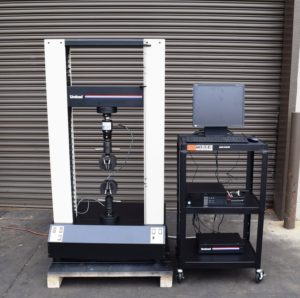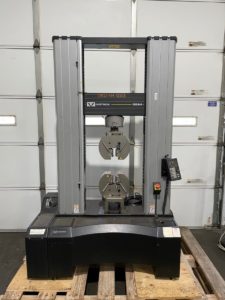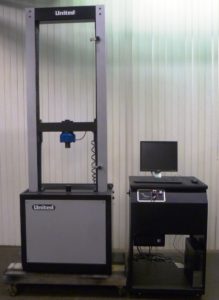
What is ASTM E8 and E8M Tensile Testing?
ASTM E8 and E8M testing methods describes the tensile testing of metallic materials in various forms. Specifically, the test determines the yield strength, yield point elongation, tensile strength, elongation and reduction of area. The information gathered by tensile tests are crucial in the comparison of materials, alloy creation and designing processes. Furthermore, the standardization of testing methods are widely accepted and used for testing of commercial materials. It’s important to note that the only difference between E8 and E8M testing is the gage lengths of round specimen but the actual testing is identical.
Equipment Required
Tensile Tester – Capacity of Tensile Tester depends on the size and the ultimate tensile strength of the specimen. Speak to one of our sales engineers for possible accommodations. Frank Bacon Machinery has over 250 tensile testers in stock in various makes, models and capacities
Extensometer – Extensometer should have gage lengths equal to or shorter than the length of the reduced section of the specimen. It should also have enough travel to accommodate the elongation of the sample.
Grips – Wedge Grips are most commonly used however various types of grips may be used depending on the sample type.
Testing Software – We recommend MTESTQuattro software for all your tensile testing needs.
ASTM E8 & E8M Procedure
• Size the specimen according to ASTM E8/E8M specifications. Specimens can be either round, flat, wire, pipe or tube. This can be performed using a Tensilkut, Mill, Lathe or Die.
• Gage punch the sample for both round and flat specimen. Select the correct guage length based on the specimen size you will be testing. This will give you the initial length for calculating elongation.
• Measure the width and thickness for flat specimens and the diameter of round specimens. This will allow you or the software to calculate the cross section area required to calculate the stress value.
• Place the specimen into the tensile tester. Flat or Vee wedge grips, threaded holder or shouldered button head holders are the most common ways of holding the specimens. Place the extensometer on the specimen. The extensometer will allow the software to automatically calculate the .02% offset yield.
• Start the test by applying the load to the specimen. The typical loading rate for ASTM E8/E8M is .2 inches/min. Once the specimen has yielded, stop the machine and remove the extensometer. With a fully computer controlled tensile tester the software will stop the machine and tell the operator to remove the extensometer. Once the extensometer has been removed, continue the test until the specimen fractures. The test can be resumed with a faster rate of load to minimize the test time.
• Once the test specimen fails, remove the specimen and put the pieces together to measure the final distance between gage marks. This will be used for the calculation of percent elongation.
• Put together a test report with the Yield Strength (.02% offset), Tensile Strength and Elongation results (Y, T & E). A stress vs. strain graph or load vs displacement graph could also be added to the test report.
• The test is now completed! If you are looking to get started with ASTM E8/E8M testing in house please contact a sales engineer (sales@frankbacon.com) at Frank Bacon Machinery to discuss your specific testing requirements. If you are looking to outsource your testing please contact jstencel4@tensiletestlab.com to get pricing and information on testing services.





